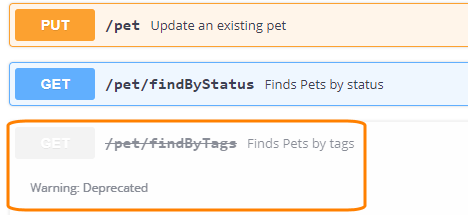路径和操作
在 OpenAPI 术语中,路径(paths)是您的 API 暴露的端点(资源),例如 /users 或 /reports/summary/;而**操作(operations)**是用于操作这些路径的 HTTP 方法,例如 GET、POST 或 DELETE。
路径
API 路径和操作在 API 规范的全局 paths 部分中定义。
1paths:2 /ping: ...3 /users: ...4 /users/{id}: ...所有路径都相对于 API 服务器 URL。完整的请求 URL 构造为 <server-url>/path。全局 servers 也可以在路径级别或操作级别覆盖(更多信息请参见下文)。路径可以有一个可选的简短 summary 和一个较长的 description 用于文档目的。此信息应与此路径中的所有操作相关。description 可以是多行的,并且支持 Markdown (CommonMark) 用于富文本表示。
1paths:2 /users/{id}:3 summary: Represents a user4 description: >5 This resource represents an individual user in the system.6 Each user is identified by a numeric `id`.7
8 get: ...9 patch: ...10 delete: ...路径模板
您可以使用大括号 {} 将 URL 的某些部分标记为路径参数
1/users/{id}2/organizations/{orgId}/members/{memberId}3/report.{format}API 客户端在进行 API 调用时需要提供适当的参数值,例如 /users/5 或 /users/12。
操作
对于每个路径,您可以定义用于访问该路径的操作(HTTP 方法)。OpenAPI 3.0 支持 get、post、put、patch、delete、head、options 和 trace。单个路径可以支持多个操作,例如 GET /users 用于获取用户列表,POST /users 用于添加新用户。OpenAPI 将唯一操作定义为路径和 HTTP 方法的组合。这意味着同一路径的两个 GET 或两个 POST 方法是不允许的——即使它们具有不同的参数(参数不影响唯一性)。下面是一个操作的最小示例
1paths:2 /ping:3 get:4 responses:5 "200":6 description: OK这是一个包含参数和响应模式的更详细示例
1paths:2 /users/{id}:3 get:4 tags:5 - Users6 summary: Gets a user by ID.7 description: >8 A detailed description of the operation.9 Use markdown for rich text representation,10 such as **bold**, *italic*, and [links](https://swagger.org.cn).11 operationId: getUserById12 parameters:13 - name: id14 in: path15 description: User ID16 required: true17 schema:18 type: integer19 format: int6420 responses:21 "200":22 description: Successful operation23 content:24 application/json:25 schema:26 $ref: "#/components/schemas/User"27 externalDocs:28 description: Learn more about user operations provided by this API.29 url: http://api.example.com/docs/user-operations/30
31components:32 schemas:33 User:34 type: object35 properties:36 id:37 type: integer38 format: int6439 name:40 type: string41 required:42 - id43 - name操作还支持一些用于文档目的的可选元素
- 一个简短的
summary和一个较长的description,描述操作的功能。description可以是多行的,并且支持 Markdown (CommonMark) 用于富文本表示。 tags– 用于按资源或任何其他限定符对操作进行逻辑分组。请参见使用标签分组操作。externalDocs– 用于引用包含额外文档的外部资源。
操作参数
OpenAPI 3.0 支持通过路径、查询字符串、请求头和 Cookie 传递的操作参数。您还可以为向服务器传输数据的操作(如 POST、PUT 和 PATCH)定义请求体。有关详细信息,请参阅描述参数和描述请求体。
路径中的查询字符串
查询字符串参数**不得**包含在路径中。它们应该定义为查询参数。
不正确
1paths:2 /users?role={role}:正确
1paths:2 /users:3 get:4 parameters:5 - in: query6 name: role7 schema:8 type: string9 enum: [user, poweruser, admin]10 required: true这也意味着不可能有仅在查询字符串上有所不同的多个路径,例如
1GET /users?firstName=value&lastName=value2GET /users?role=value这是因为 OpenAPI 将唯一操作视为路径和 HTTP 方法的组合,而额外的参数不会使操作变得唯一。因此,您应该使用唯一的路径,例如
1GET /users/findByName?firstName=value&lastName=value2GET /users/findByRole?role=valueoperationId
operationId 是一个可选的唯一字符串,用于标识操作。如果提供,这些 ID 在您的 API 中描述的所有操作中必须是唯一的。
1/users:2 get:3 operationId: getUsers4 summary: Gets all users5 ...6 post:7 operationId: addUser8 summary: Adds a new user9 ...10/user/{id}:11 get:12 operationId: getUserById13 summary: Gets a user by user ID14 ...operationId 的常见用例包括
- 一些代码生成器使用此值来命名代码中相应的方法。
- 链接可以通过
operationId引用链接的操作。
已弃用的操作
您可以将特定操作标记为 deprecated,以表明它们应该逐步停止使用
1/pet/findByTags:2 get:3 deprecated: true工具可能会以特定方式处理已弃用的操作。例如,Swagger UI 会以不同的样式显示它们

覆盖全局服务器
全局 servers 数组可以在路径级别或操作级别进行覆盖。如果某些端点使用与 API 其余部分不同的服务器或基础路径,这将非常有用。常见示例如下
-
文件上传和下载操作使用不同的基础 URL。
-
已弃用但仍可用的端点。
服务器
1paths:2 /files:3 description: File upload and download operations4 servers:5 - url: https://files.example.com6 description: Override base path for all operations with the /files path7 ...8
9/ping:10 get:11 servers:12 - url: https://echo.example.com13 description: Override base path for the GET /ping operation










